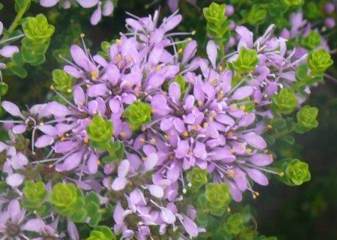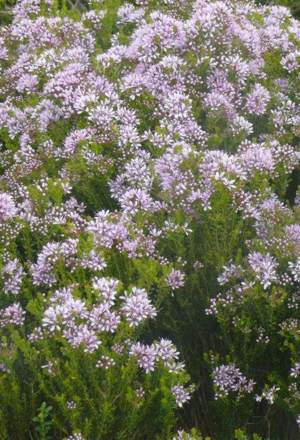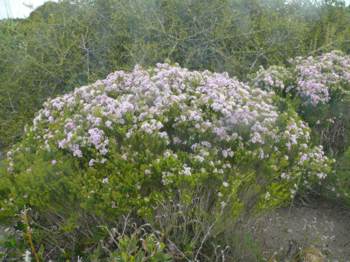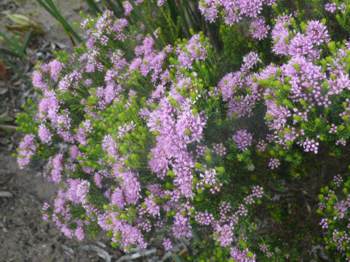Agathosma thymifolia
Agathosma thymifolia Schltdl.
Family: Rutaceae
Common names: limestone buchu, thyme-leaf buchu (Eng.) kalk boegoe (Afr.)
Introduction
This bushy shrub colours the veld in hues of pink and mauve during winter. It is a must-have for sandy coastal fynbos gardens.

Description
Description
This is a mildly aromatic shrub that grows to just over a metre, with smooth and rounded stems. Plants are single-stemmed and branch near ground level. Leaves are alternate and rounded. Pink to mauve flowers appear in lax terminal clusters at the tips of branches. Flowering time is from July to September. Fruits are 3(-4) chambered.

Conservation Status
Status
Agathosma thymifolia is threatened and has a Red List status of Vulnerable (VU).
Distribution and habitat
Distribution description
This buchu is found on coastal sand and dunes on limestone in the Western Cape from Vredenburg to Yzerfontein. This explains its common name, kalk boegoe — kalk is the Afrikaans word for lime.

Derivation of name and historical aspects
History
The genus name Agathosma is derived from the Greek words agathos which means good, and osme which refers to the distinctive and characteristic fragrance of the genus. The oil glands on the leaves and fruit normally release an aromatic fragrance when crushed. There are 150 species of Agathosma. The majority of them are confined to the Western Cape.
The specific epithet thymifolia refers to the leaves that are like those of thyme. Thyme comes from the genus Thymus, and folium means leaves in Latin. The common name kalk boegoe refers to the Afrikaans word for lime and indicates that this species grows on limestone soils.
Ecology
Ecology
Although bees are quite active on other flowering buchus, there have been no observations of the same kind of activity on this species.

Uses
Use
No cultural or medicinal uses have been recorded. Kalk boegoe is well-suited to water-wise gardening and for very well-drained fynbos gardens.
Growing Agathosma thymifolia
Grow
Sow seeds in autumn. The medium should be light and have good drainage. Mixtures of equal parts of sand and compost, or just plain coarse river sand, will do. Cover the seeds with a thin layer of bark or sand and then water. Place the seed trays in a covered area that provides sufficient good light and ventilation. The medium must never be allowed to either dry out completely or be overwatered. Germination can take from 4-9 weeks. The appearance of the first four true leaves normally indicates the readiness of the seedlings for pricking out. Handle the fine roots with care.
The potted plants can then be placed in a shady area for 3-4 weeks to harden off before placing them in full sun. This will also be a good time to pinch out the growing tips of the seedlings to promotes a more bushy growth habit. Feed the young seedlings regularly with some balanced nutrient products. Plants will be ready for transplanting into the garden after 8 to 9 months.
This buchu can also be propagated vegetatively by taking heel, tip or semi-hardwood cuttings during late autumn / early winter, or late spring / early summer. Take fresh material from the current year's growth. Prepare cuttings of 25-55 mm, remove about a third of the foliage and cut them below the node. Dip the cuttings in a rooting hormone and place them in trays with medium consisting of equal parts of bark and polystyrene. Place the trays in a mist unit with heated benches. It takes 9-11 weeks for roots to develop. Pot the rooted cuttings in a well-drained mix and place in a shady area for 2-4 weeks to harden off. After this, they can be moved into full sun. After the next 7-8 months plants can be planted into the garden.
Agathosma thymifolia will thrive in full sun and well-drained soil where it is planted amongst other fynbos species. The ideal time for planting is in the rainy season between autumn and winter. Plants should then have a better chance of establishing in the garden before they have to cope with less water or the heat during summer.
Plant the kalk boegoe with: Coleonema album , Metalasia muricata , Delosperma litorale , Helichrysum dasyanthum , Lampranthus aureus , L. amabilis , L. amoenus , Protea obtusifolia , P. compacta , P. scolymocephala , Salvia africana-lutea , Pelargonium betulinum , Lobelia valida , Chrysocoma coma-aurea , Crassula dejecta , Senecio elegans , Agathosma imbricata , A. serpyllacea , Searsia crenata , Chrysanthemoides monilifera and Cotyledon orbiculata.
Space plants about 200-300 mm apart. This should provide ample space to encourage growth. This relatively dense planting is preferred by buchus as it helps to retain soil moisture. Provide a good thorough watering during winter. Moderate watering is required in summer.
References
- Goldblatt, P. & Manning, J. 2000. Cape Plants. A conspectus of the Cape flora of South Africa. Strelitzia 9. National Botanical Institute, Pretoria & Missouri Botanical Garden, St Louis.
- Goldblatt, P. & Manning, J. 1996. West Coast. South African Wild Flower Guide 7. Botanical Society of South Africa, Cape Town.
- Gould, M. 1992. The buchus: cultivation and propagation. National Botanical Institute, Cape Town.
- Powrie, F. 1998. Grow South African Plants. National Botanical Institute, Cape Town.
- Raimondo, D., Von Staden, L., Foden, W., Victor, J.E., Helme, N.A., Turner, R.C., Kamundi, D.A. & Manyama, P.A. 2009. Red List of South African plants 2009. Strelitzia 25. South African National Biodiversity Institute, Pretoria.
- Stearn, W. 2002. Stearn's dictionary of plant names for gardeners. Timber Press. Portland.
Credits
Roger Oliver
Kirstenbosch National Botanical Garden
July 2014
Plant Attributes:
Plant Type: Shrub
SA Distribution: Western Cape
Soil type: Sandy
Flowering season: Spring, Winter
PH: Acid, Alkaline, Neutral
Flower colour: Pink, Mauve/Lilac
Aspect: Full Sun
Gardening skill: Average
Special Features:
Horticultural zones







Rate this article
Article well written and informative
Rate this plant
Is this an interesting plant?
Login to add your Comment
Back to topNot registered yet? Click here to register.